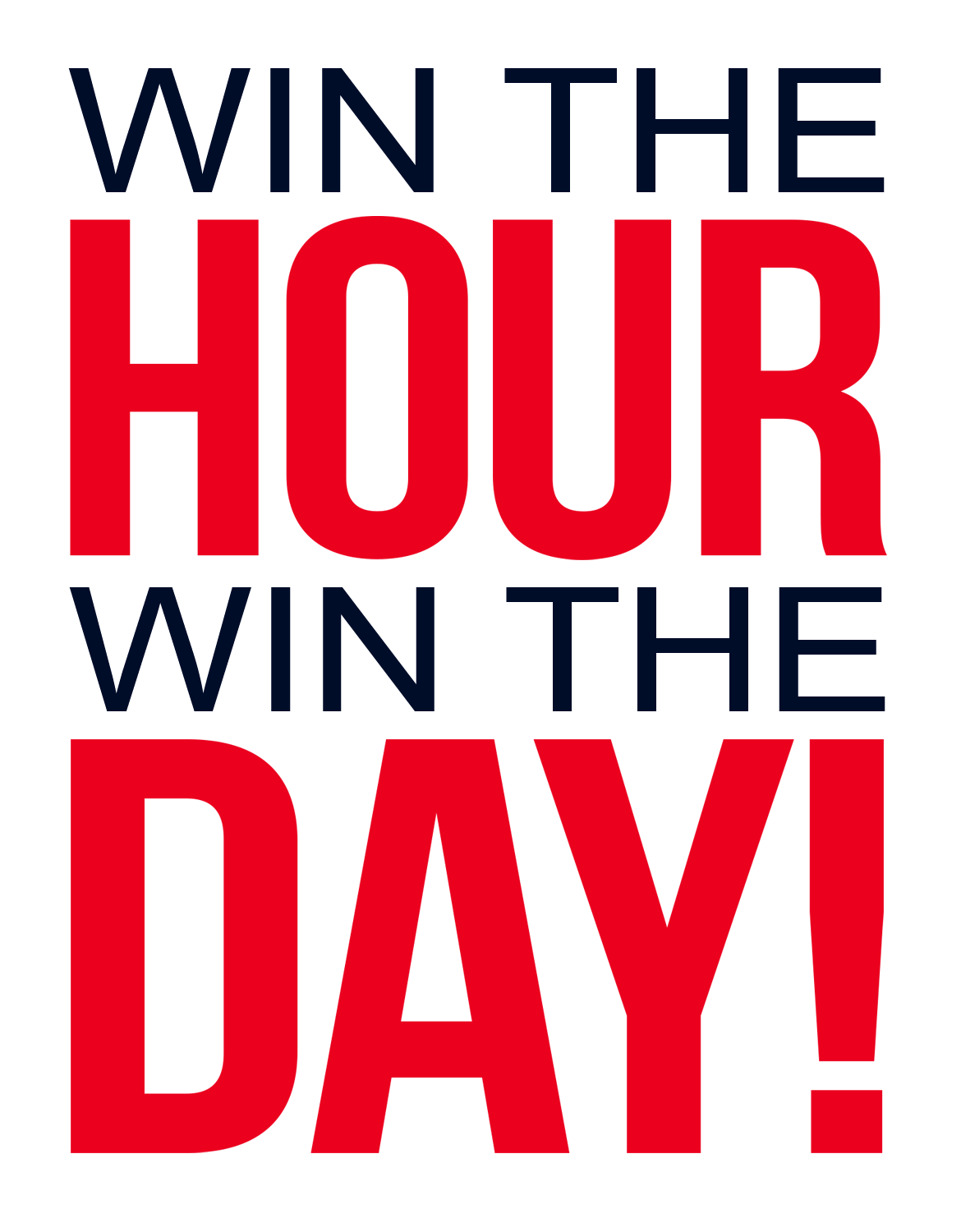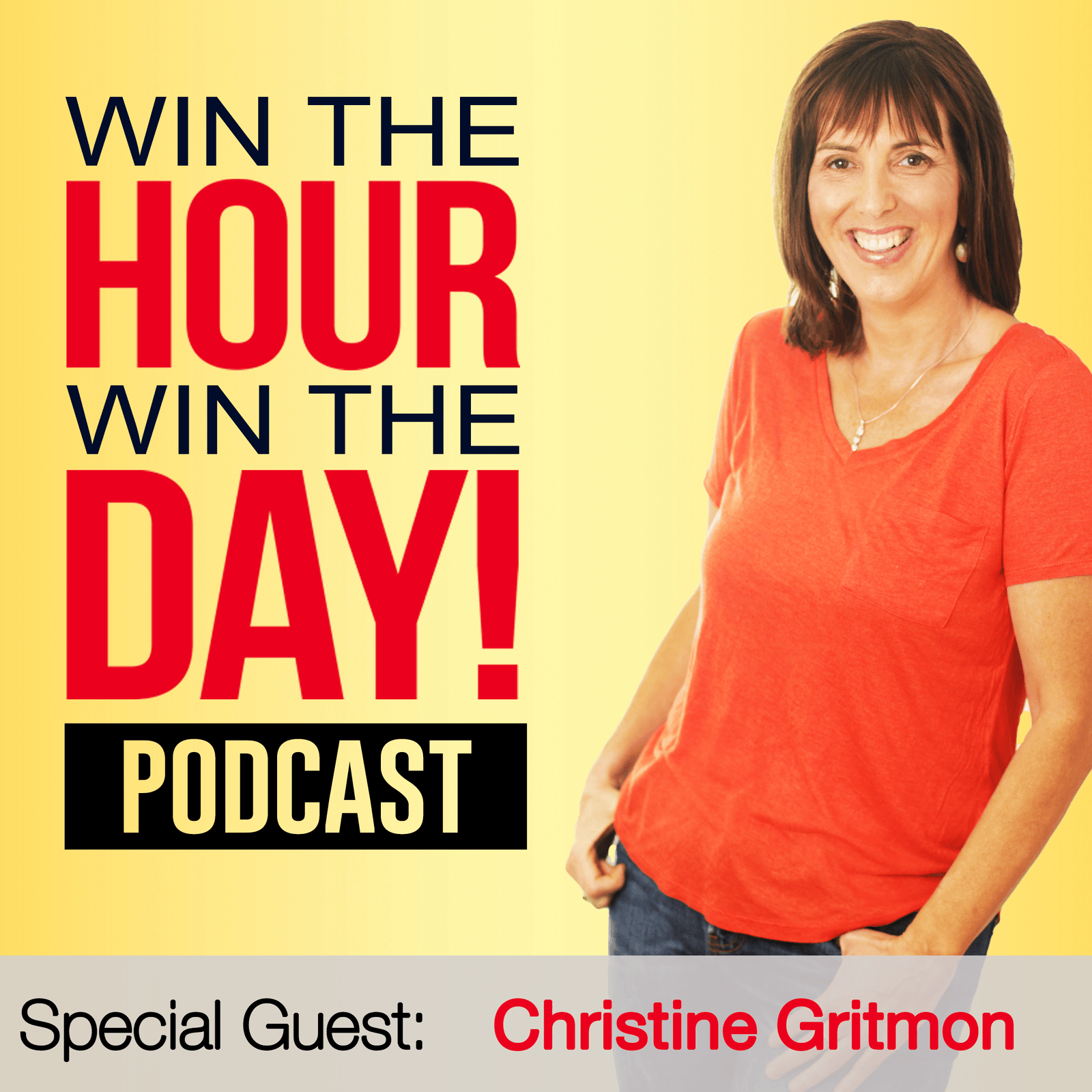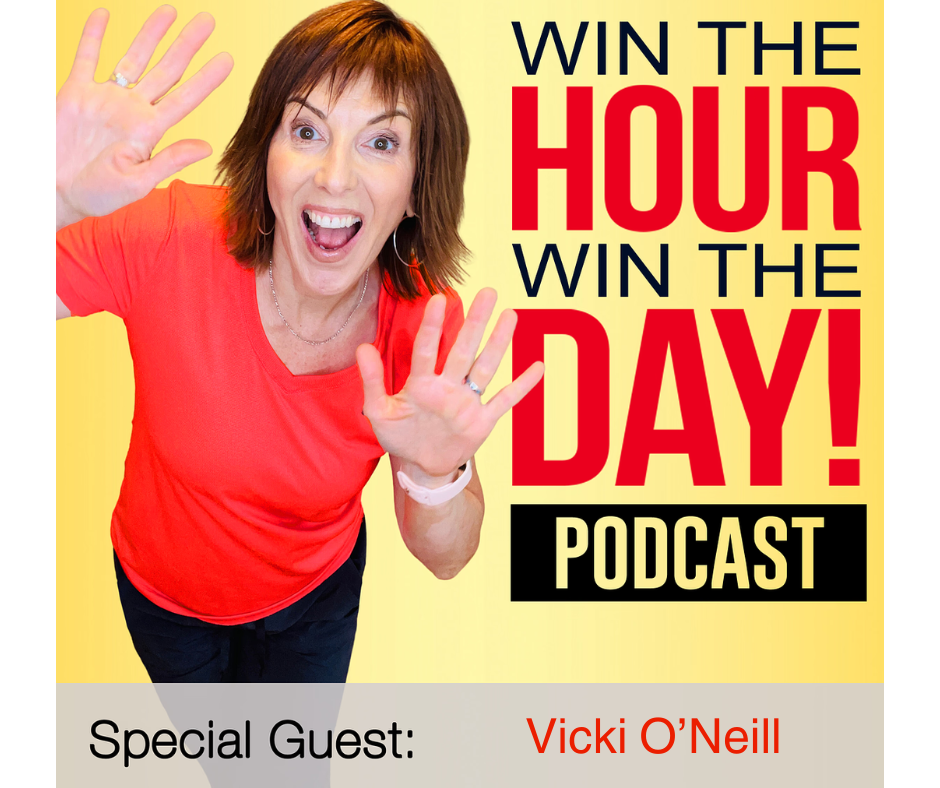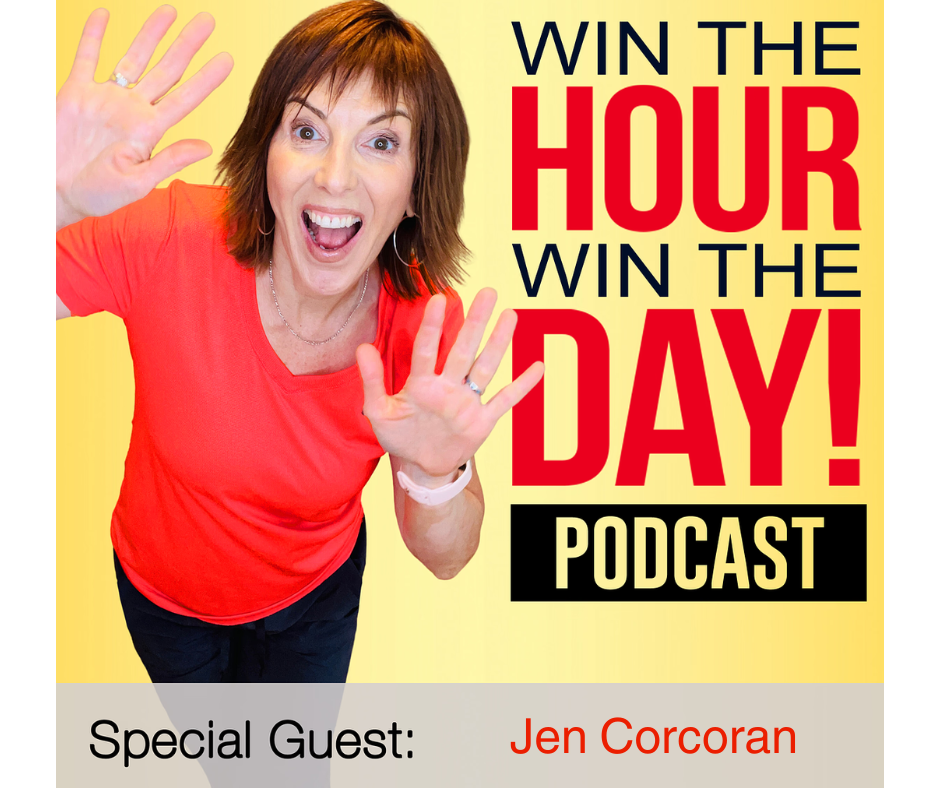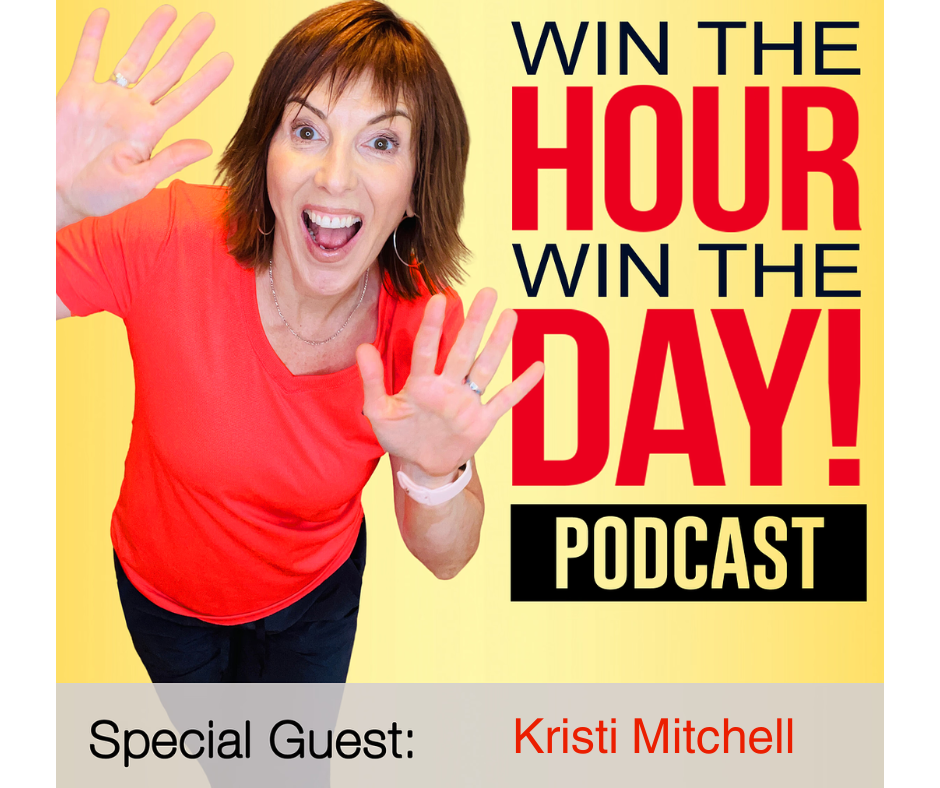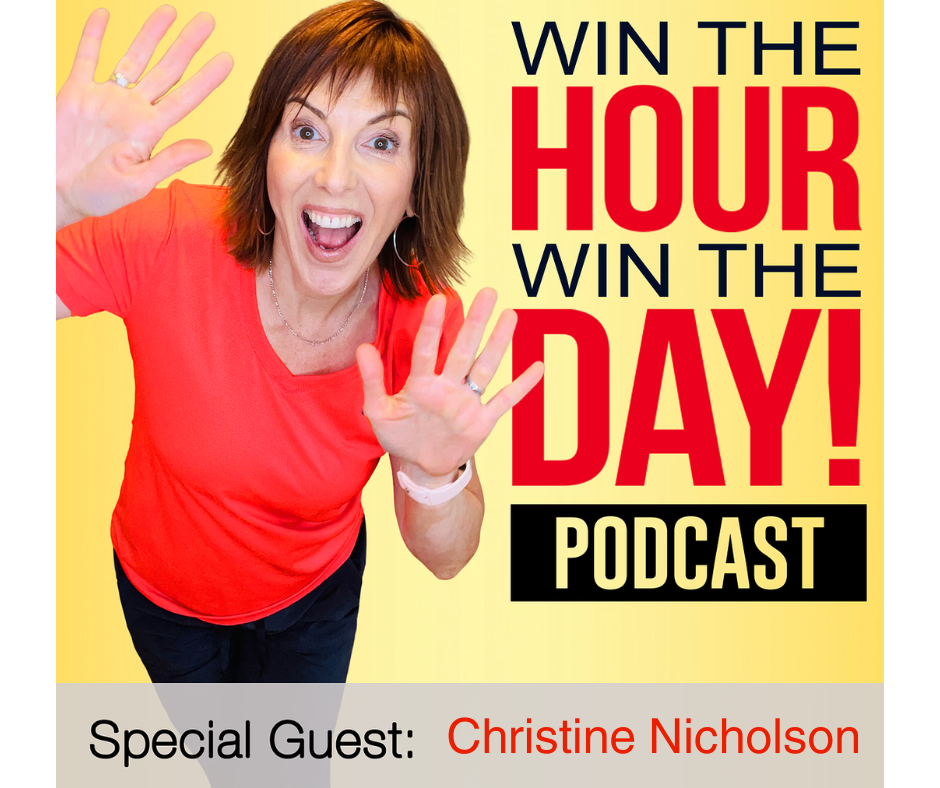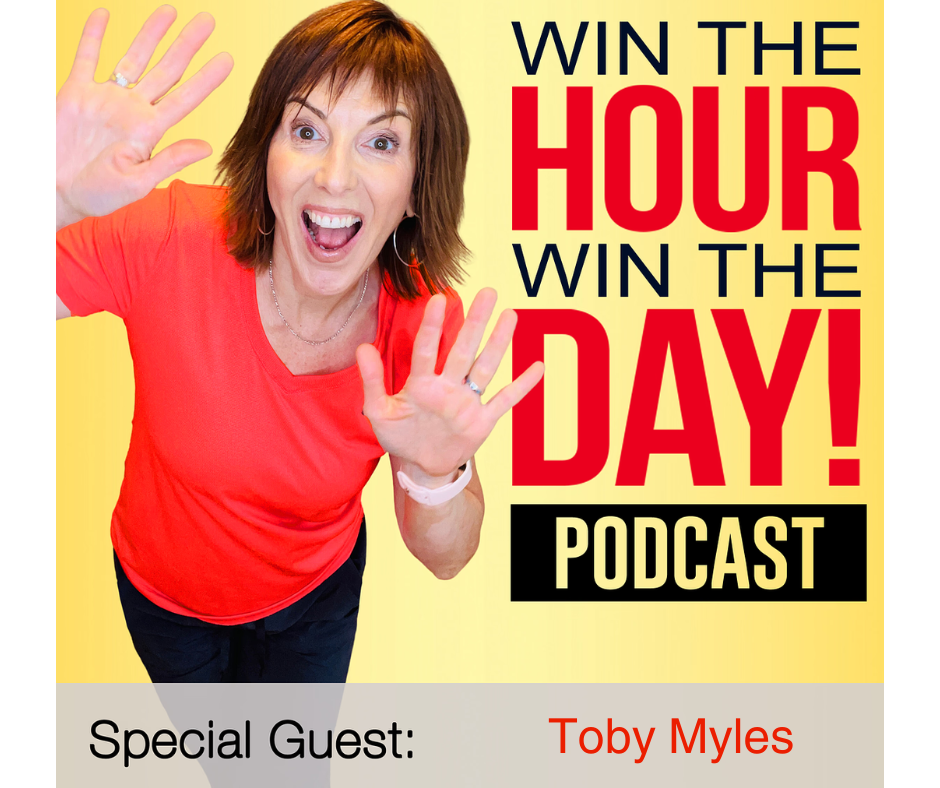Episode Summary
Christine Gritmon talks to us about how to get the most out of branding ourselves on Linkedin. Listen in as she gives us tips, tricks, and a whole new way of looking at our Linkedin opportunities.
Learn:
-The key mistakes most entrepreneurs are making.
-How to leverage connections more effectively.
-Ways to get more engagement with your profile page.
And so much more
Win The Hour, Win The Day Winners Circle
https://winthehourwintheday.com/winners-circle-masterclass
Win The Hour, Win The Day! www.winthehourwintheday.com
Podcast: Win The Hour, Win The Day Podcast
Facebook: https://www.facebook.com/winthehourwintheday/
LinkedIn: https://www.linkedin.com/company/win-the-hour-win-the-day-podcast
You can find Christine Gritmon at:
Website: https://www.gritmon.com/
Facebook: https://www.facebook.com/christinegritmoninc
Email: christine@gritmon.com
LinkedIn: https://www.linkedin.com/in/christinegritmon/
Win The Hour Win The Day
https://winthehourwintheday.com
Christine Gritmon Podcast Transcription
[00:18:36]Kris Ward: Hey, everyone! Welcome to another episode of Win The Hour, Win The Day. And I am your host, Kris Ward. And today we have Christine Gritmon in the house.
[00:18:45] I am pumped to have her here. Okay. If you’re out there and you’re on social media, especially LinkedIn, that’s where I found her. And you’re just like, doing that thing, doing the scroll. I am telling you, when you see her, you will stop. Aryt. You will stop. It gets your attention. And that is spectacular.
Not just because we all want to do that because she is all about branding. So she walks the walk, talks the talk. Welcome to the show. Christine.
[00:19:13]Christine Gritmon: Thank you so much, Kris. Happy to be here.
[00:19:15]Kris Ward: Oh, yeah. Okay. So I’m all about anything that we can get a – b, no fluff, big results, all that stuff. So branding is awesome.
[00:19:24] But you’re going to tap into a really specific aspect of branding that we’re neglecting. So, Hey, let’s just dive into it. Let’s get going.
[00:19:33]Christine Gritmon: Let’s do it.
[00:19:35]Kris Ward: So LinkedIn, you’re going to talk about what we neglect in LinkedIn and our brand.
[00:19:40]Christine Gritmon: Absolutely. And one thing that I’ll say that is truly a blanket statement for any social media platform, for any place you’re showing up digitally.
[00:19:49] If you get nothing out, you get nothing more out of today’s episode than this. I want you to understand. Fill in everything. That’s really the shortcut here top to bottom because every single piece of your profile, wherever you are, including LinkedIn is another opportunity to give information about yourself.
[00:20:10] Another opportunity to put something out there that resonates with someone else that catches someone else’s eye. And you’re also informing the algorithm. So every single social media platform out there has what’s called an algorithm behind it that decides who sees what, when, because quite frankly, if you saw everything from everyone you’re connected to everyone you follow all the time, you’d truly never be able to see anything because it would be like a stock ticker.
[00:20:38] It would just be constantly updating. So the algorithm sort of ways and measures what it thinks a given person will find interesting on their feed at a given time with the ultimate goal of keeping them on the platform. So that the platform can serve up ads to them.
[00:20:54]Kris Ward: So, okay. So then that’s a lot of really wise advice at a higher level.
[00:20:59]Christine Gritmon: I’m just letting you know, one of the primary benefits besides giving brand information. The algorithm likes it when you’re complete.
[00:21:06]Kris Ward:Okay. Yeah, yeah, yeah. So I’m agreeing with you. I’m not rushing you along. I’m agreeing with you. At a higher level, first of all, the gatekeepers. When they invite you into play, let’s say LinkedIn, they’re saying, look, we asked you to fill out everything and we are not kidding. Please fill out everything. So that’s number one.
[00:21:26]Christine Gritmon: Your profile is going to show up better in search. It’s going to show up to the right people because you’ve given them more information as to who should be seeing you.
[00:21:33]Kris Ward: Okay. So when you say fill in everything, I think I filled in everything. What are some things that people often miss?
[00:21:39]Christine Gritmon: Absolutely. So I’m going to start from most obvious to least obvious. So the most obvious is at the very top. There’s a banner there. Now, and that wasn’t always there, but it’s been there for a good several years now. Most people, hopefully at this point, have a profile picture.
[00:21:53] They know they should have a nice professional looking headshot. Don’t be holding like a margarita and a cat, unless you are a professional cat margarita manufacturer. But the top banner, I’m shocked by how many people still don’t have one. LinkedIn even has kind of generic ones that you can put up there now, but you really should use the opportunity.
[00:22:16] Not only to give people a little information about yourself, but also about your brand that can mean colors. It can mean fonts. It can just mean a picture somewhat related to what you do, or at the very minimum, some sort of imagery that conveys the feeling you want to convey or on the other end of the spectrum, it can be a plain color and a couple of words saying like your name, what you do, how to contact you, like bare bones.
[00:22:42] But so many people don’t bother utilizing that space. And that is a billboard. It’s like somebody gave you a free billboard to use. And you just didn’t put anything up on it. So that’s a really obvious one, but it still bears mentioning because so many people are still not taking advantage of that space.
[00:23:00]Kris Ward: Okay. So that’s a really good point. I definitely have a banner up on mine and I do think in the past so with that transition where LinkedIn was a little bit more. Hmm. I don’t even know what’s the word. It was, it was dry. That’s a great word. It’s a little bit more dry. So I think people could use all of this as a Facebook.
[00:23:15] Who’s going to bother with that. So you hear it, you hear it guys, make sure you do that. But then on the other hand too, I think it lends itself to, again, what you’re saying is like, oh, they’re asking you to do some basics, fill that in. Right. So, all right. I do have the banner. That’s all great. And I’ve had that for a very long time.
[00:23:32] But I think your point, which is a little bit more even salient, is like, it’s a billboard. Like we pay so much back, you know, when dinosaurs roamed the earth and we were just handing out flyers and stuff, we paid so much for that. So it is a billboard. Okay. You said obvious…
[00:23:48]Christine Gritmon: Yeah, it’s free.
[00:23:49]Kris Ward: I’m all about free. So you said the obvious to the least obvious. Keep throwing it at us.
[00:23:55]Christine Gritmon: Yes. So another thing is your headline and that’s what appears right under your name. LinkedIn defaults to having this be your current position or title and your current employer that gives people very little information. You can say, a lot of times it defaults to, you know, say for example, founder at Christine Gritmon Inc.
[00:24:16] That has given people no information whatsoever. All right. Maybe it gives them information that I started my own business. But what is founder? Who’s looking for a founder, unless they’re specifically a journalist trying to interview founders. In which case you can put that elsewhere on your profile and what’s Christine Gritmon Inc.?
[00:24:35] Unless you know, you don’t know. So basically, founder at Christine Gritmon Inc. gives people no information. The way I like to term a good headline is not what’s your position. What do you do? Yeah. So give people some sort of information so that when you come up in search, when you come across them, somehow, maybe it’s a friend of her friend, whenever someone comes across you and they’re hovering over your face and all they see is that little bit of headline, they should truly have some sense of what it even is that you do.
[00:25:10] And they should ideally be intrigued to find out more. You want to make them click with that. That doesn’t mean do something, click baby. Don’t be so mysterious and be like ‘click to find out more’. No, be informative because you don’t want everybody clicking. You want people who care what you do to be clicking.
So don’t make it that hard for them to find out what that is.
[00:25:31]Kris Ward: That’s, you know what? You brought up a couple of really good points that… so I definitely have a title and I’m clear on that. But a couple of things you said, like, you know, ‘don’t say your founder at’ which I have always struggled with and somebody actually asks you what you are, the CEO thing, come on.
[00:25:46] Like we all, we still do associate CEOs with large corporations. That’s not me. Right? So the founder and also again, I think founder to me lends itself to bigger establishment, nonprofit, all that stuff. So I have been putting, and in my case where my audience often is what I say, chasing the wrong thing.
[00:26:05] They’re stressed, they’re overworked, they’re facing burnout. And they think, oh, maybe I just need this. Or maybe I need a sales coach. And it’s like, no, we have no infrastructure in the business. So everything else they do will be short-term because we’re all about that whole 60/40 formula where you should be in an execution mode.
[00:26:19] 60% of the time. Now my case, because that needs a little bit of education. I lend itself to some of the keywords like productivity maybe even sometimes time management. That’s not really what we do. But it might be something that they think they need when they get to that burnout stage. So again, using those types of approaches is what you’re suggesting.
[00:26:42]Christine Gritmon: And you bring up another really good point, which is that the language that we use to describe what we’re offering is often a little different from the language people are using to try to find us. And we need to think more in the latter camp because while it does matter, the language that we like, and it matters the words that we choose to describe ourselves.
[00:27:01] We also really want to be find-able, especially someplace like LinkedIn. And if those words don’t connect, we won’t be find-able by the people who are using them. So really do try to look outside yourself a little bit from a search perspective and try to think of the words that people who need you are using to describe their needs.
[00:27:21]Kris Ward: Yeah. And we all fall victim to that because listen, I always say too, that 80% of websites, you’re speaking to your peers, not to your audience. And then if you went to all that book learning, I went to college and university and you do all this stuff and you’re coming at it from an academic point of view, almost like you’re presenting or you’ve been invited to speak but you’re not getting down and just talking to people instead of presenting to them.
So really I find too, oh, you know what? I’m ashamed to say this, but every once in a while, we’re really good, but we call auditing stuff. So my team has this thing where they will audit the website once a month to make sure all the links are working and this and that.
[00:27:58] But I find myself every once in a while, I’ll end up on my own LinkedIn page for something and I’ll realize, ‘oh, Oh, I could, that’s not, I could say that a lot better, or we don’t even do that anymore because we’ve got this new program replacing that.’ So I think a regular visit, which I know is so hard to structure, but just to keep an eye on visiting how the other world, the outside world is seeing what you’re doing. Not the other world. I only have one world. Everybody, write that down. I don’t hear voices, just my own.
[00:28:26]Christine Gritmon: I’m tinkering all the time. First of all, anytime I talk about LinkedIn with someone or work on it with the client. I look at my own and I’m like, this is terrible. And it’s not terrible, but I always realized I’m like, oh, this could be so much stronger.
[00:28:40] This could be so much better. And my website too. And the great thing is, I do my own website. I do my own LinkedIn. I do my own everything. So I can go in and make little changes like on a daily basis if I want to. And here’s the thing about that. You are the only person who’s really going to register. Oh, they changed that.
[00:28:59] You know, people feel like, oh, I shouldn’t go in and make tiny changes. I’m going to wait. I’m going to wait and do a whole big overhaul and it’s going to be great. And in the meantime, they have people coming across their outdated stuff. Ideally every day, if you’re lucky. So, you know, I say, just make a tweak when you think of it, because no one else is looking at your profile so closely that they’re going to be like, oh, she’s changing stuff every day.
Nobody cares. Just do it the closer you can get it to. Good. Don’t wait for perfect. Don’t wait to have all your ducks in a row. Make the tweaks as you think of them, just do it. It’s fine. A little bit stronger than that. Just fine.
[00:29:36]Kris Ward: That lends itself to what I call, you know, justified distraction, like, oh, okay. At the end of the month, I’m going to plan this day and I really focused on LinkedIn and all that other stuff, don’t buy into that. You’re right.
[00:29:47]Christine Gritmon: People put so much off. One of the biggest excuses that I hear from people about hesitating to put their personal branding stuff together is they say, ‘Oh, well, I’m about to redo my website.’
So I’m focused on that right now. And then I’ll work with you after my website’s done. Can I tell you how often those websites are finished? On time? Never, because..
[00:30:09]Kris Ward: But they need their branding for the website anyhow. Who’s the website about? That doesn’t make any sense. Don’t get me started on that one. So let’s go back into LinkedIn. Some other things that we are neglecting is we burned through this list.
[00:30:22]Christine Gritmon: Yes. So at the top, again, this is a newer function, but by newer, I mean a few years now, which is you can actually specify the categories of service that you offer. And a lot of people haven’t, there’s a whole lot of stuff hidden in the header now.
[00:30:36] That not enough people are taking advantage of. You can also record what’s called a cover video that does not go in the same place as the banner cover image. If you’ve gone to someone’s profile, people can go to my profile for example, and please do Christine Gritmon. If you go there, you’ll see my profile picture, but then you’ll see a movie.
[00:30:55] You’ll see it start talking there in my profile circle. And then it’ll go back to the picture. It’s trying to entice you to click. If you go there, you’ll hear, you know, quick. You’ll see a quick video for me explaining who I am, what I do and why you should care. That’s, again, like I said, the banner is like someone paid for a billboard for you that you just need to use.
[00:31:15] This is even more incredible. This is like someone set up a meeting for you. This is an incredible opportunity to, first of all, do the utmost branding tool, which is your own self, your own face, your own voice. You know, we have a visceral reaction to videos that automatically pulls people in a lot deeper, but it’s also an opportunity to say who you are and what you do in your own words in a really concise fashion, do not make them long.
[00:31:42] Nobody’s watching that, but if you keep it short and snappy, It’s just such a great opportunity to entice people to want to learn more. And I think most people don’t even know that that’s there, that has the videos have only been there for a month or two.
[00:31:56]Kris Ward: Yeah, let me just jump in there. So what happens, everyone out there is you go to click on your LinkedIn and then instead of your profile picture, there’s a button there you can edit and you can shoot.
[00:32:07] Like, I don’t even know what it is. Like a ten second video or something. Now kind of messed me up for a bit, Christine, because when you go on your own page, your video pops up. And then I was like, oh, I thought it wasn’t working for a bit. Cause it pops up and goes back to the picture. But I think that you’re supposed to click on it.
[00:32:21]Christine Gritmon: It’s’ so people click. Yeah.
[00:32:21]Kris Ward: Okay. So people click on that and hear you, but also even if it fails. Like I thought it was, I thought, oh, it’s showing up and then it’s going away. It catches your eye because you know, a little two second video pops up. So I think technically even if, sort of didn’t officially work, it’s eye catching and add something there, but yes.
[00:32:41] And people can click on it and hear you. Okay. Yeah. That is something. Yeah, it’s something a little newer than I think a lot of people are not aware of.. Oh, sorry. One sec. I think LinkedIn is becoming so much more dynamic and much more interesting. And so I think we’ve all been neglecting it for a while because it just had this horrible reputation for, as you said, being dry.
[00:33:03] And then these LinkedIn blitzes were just so painful, like you say, hello, and then you get this big long… I love it when somebody who connects to me and then they offer me just make all this money every month. I don’t know what selling whatever it’s like, you didn’t even like, are you, what makes you think I’m like, why do you think I’m struggling?
[00:33:20] And I need to make $10,000 a month doing whatever for you. Like, yep. Let me rephrase that. Not that we can’t all use bonuses, but their offer was so out of context without any relationship to me or what I did. So then I think we all pull away from LinkedIn, but I think it’s getting much more. You know, much more of a real networking place for professionals.
[00:33:40]Christine Gritmon: It really is, they’re making it more dynamic, as you said, they are taking a lot of cues from places like Facebook, with the cover images and all of that. But one cue that they’ve taken from Facebook that I really like is that previously LinkedIn was not a great repository for content. Your content didn’t live anywhere on your profile.
[00:34:00] Even articles, even LinkedIn articles, which is LinkedIn sort of built in blog, was kind of tricky to find. You want to do some work there and they have revamped the way they present what’s called featured content. Featured content is an incredible tool because it doesn’t only allow you to feature content that you’ve published on LinkedIn.
The featured content section used to be sort of an addendum at the end of the about section. And now it is its own section and it is above the about section. And it’s fantastic because you don’t just have to go… Go ahead.
[00:34:43]Kris Ward: Oh, sorry I didn’t notice that. What I want to ask is I was doing articles there for awhile, and then I got, was to ensure that, okay.
So if I write a blog and I put it on LinkedIn first, before my actual blog, that’s a misnomer, right? Like it should be on my blog and then we can repurpose it to LinkedIn. Correct?
[00:35:01]Christine Gritmon: So what I love doing. Here’s my LinkedIn blog recipe for you. So you do the blog on your own homepage, which is ultimately where you want to drive people to. Go on Linkedin.
[00:35:13] Start writing an article, do the title, do the header, paste in the beginning of your blog. And it’s just when it’s about to get good. Say.. Read more here. And put the link and then ask an engagement question. You really want to give them a reason to come back to that LinkedIn article and get the comment thread going.
[00:35:37] So do ask them an engagement question to answer after they’ve gone and read the full article. So that’s part one. Is creating that article. Then when you click post on that article, it will ask if you want to make a post about it, I’m on your LinkedIn feed. And of course you do. So ask a different engagement question there.
[00:35:55] Cause again, you do want them to click. You don’t want it to just be sharing a link. So as another engagement question there, after you’ve done that, here’s the tricky bit. Don’t post your LinkedIn article to your featured content section.Post the link to your actual blog post. To your featured contents.
[00:36:16] Okay. Because again, all traffic we’re trying to get to your actual website. The reason we’re bothering with the LinkedIn article is so that, that post, that you’ve shared on LinkedIn, we’ll get a little bit more reach because if you just posted the link to your external blog as a LinkedIn post, it wouldn’t get as much traction because LinkedIn does not love external links, but it’s totally cool pointing someone to your LinkedI article.
[00:36:43]Kris Ward: Okay. Yeah. Okay. So let me review this cause it’s hard sometimes when we’re not actually looking at this. So I have a blog, I’ve written a blog. Now I’m going to go into LinkedIn and I’m going to start it, the title of the header, a few images. And when it gets good, I’m going to direct you to my blog.
[00:36:58] Right. And then I’m also going to add in that post recapping here for you guys, I’m going to add that post engagement questions that they will have had to finish reading the blog. And then what they’re saying is that we can also repurpose this to a post. And again, we want to have different engagement questions, but I think what was it about the posts you say don’t put the.. in the posts we want to…
[00:37:19]Christine Gritmon: In the post, the post is, find the post we’ll link to the LinkedIn article.
[00:37:23]Kris Ward: Okay. Perfect. Okay. Awesome. Okay.
[00:37:25]Christine Gritmon: So people will see the post on their feed. Let’s click on that LinkedIn article that the post links to. They’ll go to your LinkedIn article and read and they’ll get interested. And then it’s like, oh, got to click to read the rest of the blog.
[00:37:38]Kris Ward: Okay. Okay. So we’ve got a couple minutes left. What’s some important stuff that you see missing all the time that we just want to at least touch on?
[00:37:46]Christine Gritmon: Big, big thing is people will fill in their work history, they’ll fill in their education and they won’t link to the actual pages of the institutions themselves. A lot of times companies you’ve worked for do have a company page, schools you’ve attended do have a school page, and you just have to make sure that your sections are linked to those.
[00:38:08] And the way you do that is when you’re filling out the company name or when you’re filling out the school or whatever, type it slowly. And notice the suggestions that come up. LinkedIn is dying to suggest existing pages to you. And here’s what that does. If you don’t tag it, if you just write the words, it stands alone and sure people can see it.
[00:38:28] But if you connect to that actual company page, to that actual school page, to that institution of whatever sort it is, you are now part of that network. People can search by that. Whenever I’m scrolling through LinkedIn, it keeps making little helpful suggestions to me like this person also attended Vassar College or this person also used to work at the Estee Lauder company is, you know, it’s constantly trying to make those connections for people. Those connections are what LinkedIn is all about. A friend of mine be..
[00:38:58]Kris Ward: Let me jump in there though. I kind of thought like.. Listen I’m not, I am by no means suggesting that I am old at any capacity. However, it has been more than five years since I was in university. So I was thinking, I was thinking, well, why do they care that I went to Ryerson?
Like, it’s not, what difference does that make? So I’m sure it’s in there, but you know, the university I went to, I was like, well, why would I, what’s so important about me connecting to that?
[00:39:23]Christine Gritmon: My friend, Risa Haug has a really great tip, which is let’s, let’s fast. Let’s fast forward or flashback to when travel was a thing. She’d say, okay, let’s say I’m going to LA for business or pleasure or whatever.
[00:39:40] And I’d like to possibly meet up with some prospects while I’m out there. I’d like to maybe network. I’d like to maybe, you know, get some stuff going. She will go onto LinkedIn and she’ll click on her Alma mater. She’ll sort. You don’t have to put your years that you attended on there. I know a lot of people are sensitive about that, but if you do, she’ll put in the years that she was there.
[00:40:02] So she’s now seeing everyone who attended in her case SUNY purchase between X year and Y year. And so if she sees someone who comes up in that search, who she might actually want to take a meeting with, whether she actually knew them or not, though, it can bring up people who you did know. She has an in, she can say, ‘Hey, I see you.
We were at purchase at the same time. And I see we’re in similar fields. I’m actually going to be in LA next week. Want to grab a coffee?
[00:40:22]Kris Ward: Right, right. You know what? I know this. And sometimes you forget, you don’t, you don’t see it from a different angle. Like we do that. I go onto LinkedIn and I look at things and say, okay, this is a connection.
[00:40:43] Or this could start a conversation. We’re all doing that. But we’re doing it though. It’s like planting one seed at a time instead of getting a crop. So you’re right. That just gives us another opportunity to just start a discussion with somebody. Hey, I see we both did this. Yeah.
[00:40:58]Christine Gritmon: Even something as simple, people also neglect their volunteer opportunities, causes they care about, boards that they’re on because they say, well, this is neither business nor education. This is just something I do in my personal time. That says a lot too, because a lot of times that is what people will latch onto.
It could be you and someone very similar to you in terms of education and background, who someone is going to meet with, but then they see that you are involved in a breast cancer charity, and they themselves are a breast cancer survivor. Right. You know what?
You’ve done something that made a connection that went beyond, and it’s not a tactic. The best part is that it’s genuine. You’ve connected with them on something you actually care about as a human being, which goes a lot deeper.
[00:41:47] Then just where you went to school, where you happened to work, it says something about you as a person. So don’t shy away from being complete and being a part of that larger picture for even things in your personal life as well, because you never know what’s going to resonate.
[00:42:03]Kris Ward: Yeah. And, you know, shame on me because I know of course we all know at this point about the algorithms, but I guess I got tricked or sidetracked when you scroll down your LinkedIn profile and that stuff is so way at the bottom.
And I think who’s going to be looking at that, like who cares by the time they get down here, even, even, you know the testimonials I’ve got are quite the way we have things set up. I do really well. I mean, I have, I don’t know, well over a hundred testimonials and that’s great, but again, I just wanted it to be something that kept
LinkedIn alive versus I don’t really think people are looking at them. So you’re right. This isn’t about, Hey, are the scrolling down? It’s about the algorithm. So I forgot. I forgot that. I forgot that.
[00:42:45]Christine Gritmon: I live by the algorithm. So I never forget.
[00:42:49]Kris Ward: I have the same with my coaching clients. We get coaching clients and, you know, one-on-one semi privates in our Winners Circle.
[00:42:55] And what I often say is sometimes I’m like, oh, it’s really important when you are reminded of something where you go, oh, I forgot. I knew that. I knew that, and I forgot, I knew it and I forgot how important it was. So there’s a lot to say and I knew that, but I think sometimes the stuff you’ve forgotten you knew is more important than the new stuff.
Right? Well, this has been a spectacular use of our time. Christine, where can people find more of your brilliance?
[00:43:19]Christine Gritmon: Oh God, everywhere. I’m all over the place. I would say go to gritmon.com. So that’s G. R. I. T. like when something’s gritty, like sand and M. O. N. like Monday. So gritmon.com/connect. That will show you links to all of my social media platforms.
[00:43:37] You can get on my newsletter or you can see my show, all those things. And you can also give me your information so that I can go support you as well. So that’s gritmon.com/connect. But I’m also on all the platforms. I’m on LinkedIn, Twitter, Facebook, Instagram. I don’t really do TikTok though. Sorry.
[00:43:57]Kris Ward: No, I haven’t.They haven’t talked to me into that yet either, but, and I have to say, you know what, I’m very fortunate. A lot of people give me a lot of compliments about how we put our brand out and what we’re doing. And I’m really always, you know, quite pleased if I, you know, I’m like, okay, I’m doing something right.
[00:44:11] But. Hats off to you. You pop out on the page, like you own the page that you’re on. It doesn’t matter what’s happening. If you’re scrolling, it’s like, it’s like academy award lights go shining on you. You do a spectacular job of it. So you guys, you gotta check her out just to see that. Cause it would literally leap off your page. Anything that she does.
[00:44:31]Christine Gritmon: So I help other people do the same. I help make sure that all the spotlights are shining on you.
[00:44:37]Kris Ward: Well, clearly you’re good at it. So that is a.. that’s a no brainer. All right, everyone else, we will see you in the next episode. And Christine, thank you again.
[00:44:48]Christine Gritmon: Thank you so much for having me, Kris.000
